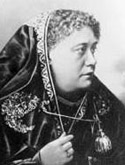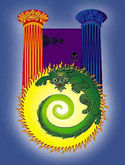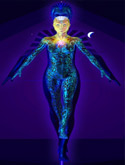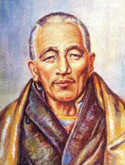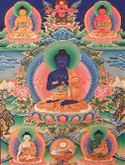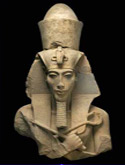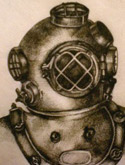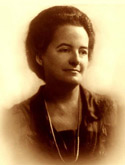“I was brought into light by the shade of great enemies” Agni Yoga, v.270
Saturn, the archetypal dweller on the threshold of Self.
The seventh exaltation resonates with the first (the exaltation of the Sun in Aries) as its echo and counterpart. Through the opposition and complementarity of the signs Aries and Libra, a polarity is revealed between the Sun and Saturn, and a partnership exalted between their functions within the universe and the human psyche.
Saturn is the “Satan” of the old astrological lore, carrier of all fateful events, negative dispositions and malefic influences.
In their exalted rapport, Saturn and the Sun are set across the horizon, “back” to face – as twilight to dawn; as fall (Libra) to spring (Aries); as the unconscious shadow to the radiance of the Self; or as the enemy-friend guarding the next gate of the emerging Self.
The sun sets and “falls” in the West (Libra) – the West of all “Satans”. The “Light from the East” falls in the Western worlds where “gold” materialises and science and technology are exalted. Yet, it is out of such science that the full light of man will arise, shining through his creative efforts and achievements (Saturn).
Their exaltation in opposite signs reveals an underlying partnership between the two principles. On one hand, Saturn-Satan is set up as a partner to the rising of the sun; he is a key participant in the dawn of dynamic selfhood. On the other hand, the self-expression or the creative will of the exalted Sun (Sun/Aries) calls for the balancing and adjusting function of Saturn (Libra). Saturn is the dark partner in the exaltation of the light, the pressure of the “notself” destined to elicit Selfhood in the evolving consciousness (Sun), the resistance of matter which makes spirit “spring” (Aries). It is by having to emerge from the limitations of imprisoning matters that the Self is exalted.
On the archetypal threshold which Libra represents, Saturn stands as the dweller who veils and eventually reveals the Self. He guards the temporary ring-pass-not of a self and reveals the threshold to greater Selfhood hidden in the limitation imposed by self-consciousness on a broader sphere of reality and I-dentification. He guards the ascending thresholds of a self through the widening spheres of Selfhood – ever a custodian and sober reminder of the relativity (Libra) of Identity (Aries).
Saturn as universal dweller: the relational Necessity of creation.
The exaltation of Saturn in Libra also points to the relational foundation of creation, the relational nature of the axial law along which the universe, and anything in the universe, constitutes itself and evolves. This ongoing “con-stituting” of the world-Fact – the task of “con-statuere” (lat.), that is of “setting up” an evolving world as a “co-herent” manifestation of its indwelling self – is the exalted function of Saturn, and in fact a literal translation of Saturn/Libra. In the accomplishment of this task, Saturn stands for the Law which faces and confronts each and every expression of free will (Sun/Aries) in the world – the relational Necessity (Saturn/Libra) which governs universal existence. All that springs from the initiative of men and the creation of “gods” is naturally placed in the balance of its relation to the whole and subject to the adjustments which the needs of a greater context require from the singular expressions of its units.
Saturn’s exaltation in Libra suggests that the law which the planet is known to wield is a law of justness in all relationships. The expressive impulse or creative idea of an individual (Sun/Aries), touching the “bounds” of the whole, meets this law of all interrelatedness (Saturn/Libra) which confronts the “initiating” one with adjustments of will to will, action to reaction, rights to rights, freedom to freedom, or particular idea to comprehensive purpose. As Libra guards the horizon of Aries with the measure of the “Other”, Saturn makes its rounds on the “borders” of any creative source, dwelling where the expression of s/Self meets resistance – this can mean the resistance of matter to Spirit and of man’s egotistic will (“Satan”) to God’s will, or it may be as well the resistance of a person’s or a group’s integrity to someone’s actions or ways, and the resistance which a greater purpose may oppose to creative initiative throughout cosmos.
Saturn is the resistance of Necessity.
It represents the necessity, intrinsic to universal Being, to venture both freely and as One – in the freedom of Its units and the convergent will of the whole. This Necessity is, in a certain respect, the essential axis of the universe. Though outpictured as an horizon (Libra) and peripheric border to the rising force of the will (Sun/Aries), the law exalted in Libra is an axis, a central reality, a hub where all motions – pulls and counterpulls – of cosmos resolve into the central spine of evolution.
In terms of human experience, this spine translates into the law of karma. Karma is the law of universal ad-justment – the inherent tension-towards (‘ad’-) that which is just and around which the integrity of the universe constitutes itself. The resistance of Necessity is the reality of the universal Dweller. Even though the dweller often seems to come and meet us from the peripheries of experience, it pertains to the indwelling self and is the projection, disguised under the objective side of life, of one’s very will-to-integrity – the will to be One, as a person or as a universe. It is the shadow cast on circumstances by the distance between a personal inclination and the central axis of Being. The peripheral encounter is but the reflection of a one-sidedness in our relation to ourselves, an off-centeredness in our alignment to the whole, a bias in a group’s relation to its Self.
This spine of universal justness is the expression of the evolution of the whole as One Self, truly creative and free throughout its parts, while inevitably One. It builds itself around the very core of the universe – the free will of creative Being. In fact, the law of adjustment and right relatedness is like a natural ossification of this universal marrow of spirit Free Will, an “invertebration” of the vortex of Being precipitated into existence- the armature of spirit and the existential manifestation of freedom.
Saturn is the custodian of the “central boundary” where the will of each is encountered by the necessity or Will of the whole, where the freedom of each “articulates” with the integrity of the whole and the choices of each condition the whole- where existencial separateness meets essential Identity. The law, which Saturn represents, is the expression of the inner equilibrium (Libra) which, claiming its necessity through karma, affirms the stance (Saturn) of the One Self we are as a universe.
Adjusting will to Will, Saturn balances cause with effect – the effects caused by any expression of will. It limits and rebalances the expression of individual free will with the effect of its enactment on others. It redresses the part with the response of the whole, reshapes it to Its need. The natural limit to what we do to each other and to the whole is ultimately the “resistance” offered by the hub of free creative Life which passes through the core of each and all of us – the reality of our essential Identity. The facts of history and the law of karma are the expression of this fact in time and space.
The law of right relatedness is the call of universal Identity throughout the worlds of duality. What I do to you is what I do to (my)Self.
To each limited perception and separative action which diffracts the lines of a vaster plan and distorts the axis of a greater sphere to which we pertain, karma sooner or later presents “the other” side – the counterpart which implants or redresses within each entity (be it a man, a group, a nation, a planet, a solar system) the axis of the whole.
Through the sweeping tides of offenses returning as pain, of omissions returning as summons, through debts reborn into sacrifices, flaws bent into faculties, karma weaves this “righting” of relation which builds the spine of the great world-being. Ceaselessly are decisions offset by the current of a larger Necessity, chosen directions ebb under the flow of greater realisations, old thought-waves are whip-lashed by smiting events – self is confronted and reshaped by Self. As the tides leave on the seashore a distinct spine of sand – the trace of their encounter with the earth – Saturn weaves the shore of spirit in the denser worlds of human matters. On the shore of eternity, it weaves time and the spine of history – a design of events and destinies. On the shore of spirit freedom, it precipitates the laws. In space, it crystallises the objective worlds- the skeleton of the mineral worlds which the relation of a logoic Life to Matter leaves on Its shores.
Saturn shows the reverse side of the freedom of spirit (an astrological evidence of this can be read in the hierarchical rulerships of Aries and its “reverse side”, Libra – Uranus and Saturn). It constitutes the matter side of God, the mask of duality (Libra) under which manifestation in time and space veils the One, or the mask of resistance through which the lesser worlds experience the promptings of soul or spirit. Saturn represents that with which these lesser worlds carve the existential face of Divine Freedom – the laws. Laws are but the reverse side of Freedom – the back of God, as karma is but the “other” side – “our” side, the dual side – of Oneness. Karma is both an effect of the Oneness-that-is and a builder of the Oneness-to-be.
Saturn – the backbone of the Universe.
We find a refraction of this idea in the axial function which is that of Satan in Dante’s spiritual geo/cosmography. As the two travellers of the “Divine Comedy” reach the threshold between the “downward spires” of hell and the upper worlds of Purgatory and Paradise, a powerful image unfolds of Satan as the spine of the lower worlds, head down into the abyss. Hell and paradise hinge on His hips (Libra). He is the “diabolic” one – the one “thrown across” (Gk. dia-bolos) space to separate heaven from hell and darkness from light; the devil precipitated across eternity to ripple it with the cycles of Time and the spirals of Evolution. He is the “divider” (devil/diabolos) risen from the natural foundation of the world to raise self-consciousness. He is the rent of self-consciousness in the seamlessness of the world-Being and that which dwells in this gap and keeps it open through the ambivalence of free will. He is that which by the same token allows the world to fold back into itSelf and to stitch through man’s choices the central seam of its freely realised unity.
As Law is the precipitate of the universe’s creative spirit and karma the effect of the reality of Oneness, so is Satan the precipitate of a universe’s freedom. Planted upside down in the moral psyche, Saturn-Satan elicits the building up of conscience, and on the hips of the psyche that conscience represents, the engulfing circles of hell “convert” into the aspiring cycles of purgatory and the ascent to paradise:
“When we had reached the point at which the thigh revolves”, Dante recounts “just at the swelling of the hip, my guide, with heavy strain and rugged work, reversed his head to where his legs had been, and grappled on the hair, as one who climbs – I thought that we were going back to Hell. “Hold tight, my master said – he panted like a man exhausted – “it is by such stairs that we must take our leave of so much evil”… “Before I free myself from this abyss, master,” I said when I had stood up straight, tell me — how is he so placed head downward? Tell me, too, how has the Sun in so few hours gone from night to morning?” And he to me: “you still believe you are north of the center, where I grasped the hair of the dammed worm who pierces through the world. And you were as long as I descended; but when I turned, that’s when you passed the point to which, from every part, all weights are drawn”…
In this dramatic illustration of Saturn in Libra, the world stands on Satan’s hips (hips are traditionally ruled by Libra). It revolves around that power which precipitates the “paradise” of the formless worlds into time and space, while offering the very steps of return from “hell” to “paradise.” The world revolves around the “diabolic” hip joint which articulates the abysses of the world-matter and the heights of the world-light. The gravitational point, the “riveting” center of separative gravity is also the pivotal place of the world’s panting efforts out of the downward pull of matter. It is at this threshold of deliberate choice that shiftings occur in the orientation of consciousness – out of the self-centered worlds of Satan into the radiant worlds of the Sun. The hips of Satan are the very hips of the world consciousness.
Two dimensions of Saturn need to be distinguished: as the separative law of matter and form, Saturn generates the gravitational field which resists the unboundedness of spirit for the sake of building self-consciousness and securing personal integrity (its exoteric rulership of Capricorn); as the synthetic law of spirit, Saturn resists the limited expression of a s/Self, challenges the bent of particular choices or limiting ways for the sake of a more comprehensive design (in its hierarchical rulership of Libra).
Dante’s picture shows how these two sides of Saturn articulate around the “hips” of the great Divide; how they struggle in man’s efforts to negotiate within his consciousness the pull of matter and the pushing through of spirit – self and Self. The dynamic effect of the Saturn principle – its central presence as Satan in the world-picture – shows itself in the twisting motions and inner shiftings of evolutionary choices through which mankind slowly raises its Self.
The separative law of matter hides the promise of individualised selfhood. Within the particular gravitation of a person’s psychic field are hidden his/her stairs to the Light; within his/her unconscious ‘tendencies’- deliberate spiritual “intendings” await. The line of least resistance of the lower nature (“below the hip”), “The point to which, from every part, all weights are drawn”, is also the path of highest resistance for the soul, a path of soul invigoration paved with opportunities of reversal through effort, of liberation through steadfastness. More and more clearly identified as the threshold of the soul realm draws near, the line of most resistant self-preservation or irresistible self-focus points precisely to the steps of “heavy strain and rugged work” across the next threshold of selfhood.
To Satan’s upside down position, bound to the alienating urges of separative selfhood, Dante opposes the upright stance of spiritually intent man. Around the commanding presence of Satan/ Saturn, automatic inclinations find their way into autonomous gestures of Self, tendencies are reversed and arise as intentions. Saturn is the “staircase” of the world’s emergence from its captivation by the gravity of all matters. It is the builder as well of the gradually emerging spine of a world raising its Self from unconscious activity to Presence – Saturn is evolution in the making. By affording each and all with the opportunity to spiral up from self-centeredness to Self-“centration,” it induces choice. From the precipitate of humanity’s choices, Saturn builds history; and with the cement of history, it ossifies the gradual en-vertebration of our universal stance – the ossature of our evolving world-Self.
The builder of the spine of Selfhood- Other of God, Other of man.
Through “Satan’s” precipitation of creation, choice is offered to be pulled down or to step up. Through Saturn’s divine adversity, man wrestles his spiritual stance out of the pull of “egocentric gravity,” reorients to the “light” and redresses his selfhood to the axis of a wider sphere of Identity.
The sign Libra, in which Saturn is exalted, is the hip of the zodiac and the central “articulation” of the One – the place, archetypally, where the zodiac “bends” to join itSelf, and each zodiacal end bends to join the other .
It is so not only in the sequential exoteric space of the zodiacal circle, but in what A. Bailey calls “intermediate space” as well:
…“The constellation Libra” she writes, “occupies a unique place in the Great Wheel, for it is the energy coming from this constellation which controls what we might call the “hub of the wheel”.
This is that point in intermediate space where the twelve zodiacal energies meet and cross. Libra, therefore, controls the “moment of reversal of the wheel” in the life of every aspirant”… the point-moment where each meets its other.
Satan is “the other” of God. He divides the One Logos along His very Logic of freedom, the principle of free selfhood. Saturn is “the other” of man. The dweller who represents what separates man from (him) Self, he stands on the threshold of his expansion into a larger sphere of identity. He is the face of his limitations and the step across his ring pass not. He meets man across the aisle of his day and stands in the way. Dressed in turn as friend or foe in the ambiguous garment of Libra, he confronts man’s dual nature with the divinity hiding under his weakness or the evil lurking under his brilliance. He may wear the “sublime” we fear, as well as the weakness we deny.
As Satan is the adversary of God and His most intimate co-laborator, Saturn presents man with adversity – the adversity he needs in order to build his right stance in spiritual being.
The biblical God himself, the very god who casts down Satan-the serpent, occasionally takes on the ambiguous character of the Adversary. He tries to kill Moses after sending him on his mission,
“The Lord said to Moses, ‘Go back to Egypt…’… On the way, at a place where they spent the night, the Lord met him and tried to kill him.” He attacks Jacob at night, after saying: “Return to the land of your kindred, and I will be with you”
The mysterious episode of this nightly encounter is another quasi-mythical presentation of Saturn in Libra. Like Dante’s Imagination, it presents a turning point and a threshold of reversal. Jacob is coming back from twenty years of exile, having fled the killing rage of his twin-brother Esau – his “other.” Approaching Esau’s land, he sends messengers before him to appease his brother with presents. The day before the encounter, he is distressed and “afraid that [Esau] may come and kill [them] all”. As he is “left alone” that night, having sent his two wives and eleven children across the stream which borders the land, “a man” meets him and “wrestles with him until daybreak.” Who this “man” is remains mysterious. He is the archetypal “Other,” whose countenance shifts in the shades of the night – the obscurity of the divided consciousness. If he is a lighted One, why does He want “to go, for day is breaking–?.” If He is a powerful One, how is it that He could not master” Jacob? In fact, seeing he could not master him, he “dislocates Jacob’s hip”. Yet, of him Jacob will say, “I have seen God face to face.” Is he a man? Is he a God? He seems to carry the ambiguity of Jacob’s alternate perception-of, and identification-with his own higher Self attempting to “master” his frightened psyche. His shifting face is that of the archetypal Dweller on the threshold which separates ego and Self – the “man” and the “God”, the inner “brothers”. A threatening adversary, the mysterious man turns to be a blessing angel (“I will not let you go, unless you bless me”). From under the attack of ego fears, arises the blessing of the indomitable Self. Two, yet one.
Saturn is the other face of the Sun of spirit, the fear of the separate which summons the dawn of the One, the illusion of duality through which each unit grows into its Self. Fear is the “devilish hip” of soul-strength, the spasm of the ego against soul love or spirit’s Life. It points to the articulation of the spiritual man within the lesser self. It indicates where the hip may be located within the psyche – the revolving threshold between the exile of enslaving fears and desires and the reunion in solar freedom; the shifting point of personal illusion where hell can turn into paradise. It contains the very steps out of the ego’s gravitational field; it points to where the soul can find its surest grip out of the present “infernal” circle. In the fear of internal or external adversity dwells the opportunity to find a wider based “balance” by with-standing (Saturn/Libra) God’s power or soul’s pressure with its equivalent, with “equal valor”, or to step through destabilizing doubts and “dislocating” forces into the daybreak of a fuller Selfhood.
Out of the hand to hand wrestling, or more precisely in the equilibrium of the two (Libra), a new strength emerges in Jacob – the spiritual authority (Saturn) of the one who has “measured up” (Libra) to God: “Your name shall be Israel, because you have been strong against God, and shall prevail against men.” Like the straight spine stemming from the balance of the hips, an exalted stance (Saturn) stems from such measuring up (Libra). This spiritual spine (Saturn) rests on a new co-measurement (Libra) of the lesser man with his divine Self. It arises from a unifying within Jacob of “the one” with “the other”(Libra), which the embrace with Esau illustrates the following day. “Esau ran to meet him, and embraced him, and fell on his neck and kissed him, and they wept..”
In the unification of soul and personality staged here, Jacob’s true spirit – the spirit of Israel – takes its stand. Upon the reunification of the sons of Isaac, “Israel” arises through its third Father (Saturn). Soon after, the birth of Jacob-Israel’s twelth child heralds the radiant leadership of an archetypal One-among-the-twelve, a human jewel in a lotus of twelve tribes. He has crossed his inner “gap” and founded his spiritual stance in the embrace of his “two,” in true Selfhood. (Saturn/Libra).
Interestingly, this new stance and moral status of Jacob-Israel is rooted in a limp – a dislocated hip. So are Saturnian strengths within the psyche rooted in a particular lack of balance, a certain dysfunctionality which exalts the “righting” work of the planetary principle. Such strengths arise in a place of flaw or disproportion, of inappropriateness or in-adequacy, a place which needs realignment, fine tunings and adjustments. We learn from Jacob’s name that he was born “The one who supplants.” Born second of the twins, he had bought Esau’s birthright for a lentil stew, then usurped their father’s blessing destined to his first-born. Now, at this turning point in his life, he finds himself overwhelmed by the return of the “supplanted” twin and almost overthrown by his Dweller. In this facing and union with his own unredeemed self, a new equilibrium is found. A central spine of leadership and national identity emerges from the reunion of the two. It is rooted in a limp – precisely the karmic adjustment of a will-to-supplant.
It is interesting to consider how this very theme of “supplanting” the “other” and being supplanted seems to have haunted the history of the Jewish people and fed the collective shadow which ended up turning a diffuse fear into a sore fact in the Middle East. Rampant as a threat in the centuries of diaspora (where the Jew was made into “the other”), the mythical fear of supplantation has now been given the solid “grounds” of a resented fact – of lands and occupied territories.
Can a right line be drawn between the two brothers and sons of Abraham – Ismael and Isaac? Can a rod be forced into the tenuous line of unstable borders and settlements? Or will a spine of right relation emerge from an as of yet unthinkable embrace of each twin by the other? Will the other have to be met through fear and night as the face of God and make the first “limp” in the blessing, supplanted by a realisation of unity? Jerusalem, the city of Peace, is at the heart of the question, as Shamballa – the city of Peace – (ruled by Libra) holds the axis of our Identity as a globe.
This profound theme of supplantation, which carries collective fears, projections and demonizations, contains no less than the Idea of a unified world-consciousness and the germ of a global spine. The “Axis” forces of World War II – one of the most monstruous lines to have divided mankind – were if anything a caricature of this. The XXth century “Satan” stood on the obsession of supplantation, replacing what he perceived as the supplanting will of the Jewish people with the dominance of the Aryan race. Saturn is exalted in the Idea which has been striving to shape the spine of the collective goodwill ever since – that of right relating among “United Nations.”
From the biblical Satan to the “man” who wrestles with Jacob, to Hitler surging on the path of humanity, Saturn is the Other who eventually elicits the One and “rights” the relation of the partial consciousness with the whole.
Continuing down the Judeo-Christian line of authority figures (Saturn), these reflections about the character and identity of Saturn conjure up the figure of Moses. In the process of becoming the leader and “spine” of the Hebrews (Saturn), Moses has to stand up to (Libra) their collective dweller by the red sea – the Egyptian Pharaoh – until the ineluctable contractions of karma, the ten plagues, deliver the path across which he can take his people into a new sphere of integrity. Of this sphere he is the axis, the “staff of God” among his people. He is their “I,” and his sign – the sign of the serpent-staff – is like an evocative replica of the satan-spine of Dante’s world axis – an emblem of the bipolarity of a world rooted in free will. The poles of matterbound lawlessness (snake) and spiritual lawfulness (staff) are the two poles of the divine axis of free will which runs through the universe as the very “I” of its Identity.
This sign of the “Divine Spine” with which Moses is invested announces his spiritual mission as the Law giver. When he brings the Tables down the mountain, it is the backbone of a divine Order that he plants in human matters to draw the line between right and wrong (Saturn/Libra) – a structure of commandments destined to shape and organise human living according to the basics of right relating. We find in the biblical account a transparent illustration of the idea which had emerged earlier – of Saturn as the Law and of the Law as the back of God. To Moses, who has asked the Lord to show him his glory, is granted a vision of His back,
“See, there is a place by me where you shall stand in the rock, and while my glory passes by I will put you in a cleft of the rock, and I will cover you with my hand until I have passed by; then I will take away my hand, and you shall see my back; but my face shall not be seen.”
The Law-bringer is the one who knows “the back of God” and seeks to shape the physical worlds and organise the social worlds into the objective or the “reverse side” of God they are meant to be – a structure which begins to reflect divine rapports and relationships. Destined to create the frame of a lawful social organism, the stone tablets of commandments are like divine vertebrae taking hold of the chaotic matters of human living. Within the backbone of “do’s” and “don’ts” the glory of God stands hidden, and although the influx of Life “passes” down, it is unknown and unfelt as such. Yet Its presence creates the pressures and tractions necessary to shape the right stance of a human group and the behavior of its individual members, until the basic laws of human living become as instinctual as physical balance and coordination.
Saturn is the other side of the living God – its existential side – the reverse side of the hub of Being – the backbone which ensures the active penetration of the commanding marrow of Life into the many lives. The significance of the law is in its slow bringing of the Below “in accordance” (Libra) with the Above, so that a degree of spiritual integration may begin to show in the physical life (Saturn).
“Have them make me a sanctuary (Saturn/Capricorn) in accordance (Libra) with the pattern I showed you on the mountain, so that I may dwell among them.”
Laws (Saturn) are the expression of the ongoing ad-justment – that is the bringing about of a just relation (Libra) – between the peripheries and the core of worlds, between concrete matters and their idea or spirit. “A law, A. Bailey writes, is but the effect of the continued intelligent activity of the Life aspect as it works in conjunction with matter.” It is the unfolding conjugality of the two (Libra). Saturn’s essence and reason to be is the collaboration (Libra) of matter and Life, of the many and the One. Its manifestation is the law (Saturn). The law is the temporary seal on what constitutes at a certain point in consciousness a “fair” relation between the right of matter and the right of spirit.
The inner reality of the Law, “exalted” in Libra- Love.
With the next law bringer, the Christ, the “back of God” begins to glow with the living element of the law and its letter – the spirit of right relatedness and the substance of love. Now the Face of God passes among humanity: “Whoever has seen me, has seen the Father.” That the exacting and punishing old testament God may show His face of love on the earth speaks to humanity’s readiness to see with soul into its own soul and to respond in its choices to the soulful quality of “lawful” actions – to imbue itself, its law abiding self, with soul, solarity, Christhood. The divine blood running through the human, then the planetary, body actualises the ensouling presence of the One sun of Self. In the new “commandment” given by the Christ, “that you love one another,” the Capricornian back of the law discloses within its tight texture and rigid bones of rules and practices, the unifying force of love – the wise will to harmonise and unify (Libra) which, in truth, inspires and “inspirits” the disciplining character of the law. The law is exalted in the principle of just relation which lives in its core. In the exalted understanding of the law, it may be more “right” to heal a fellow man than respect the interdictions of Shabbath. It becomes more “just” to forgive than throw the stone of retributive “justice”.
The multiple rules and regulations of the old law sought to remind the externals of existence of their greater model – to carve the letter of God in man. They marked this rapport in the flesh (circumcision), in the rhythms of time (from shabbath to festivals), in the proportions of space (the Temple), in objects and rituals. The one commandment of the new law awakens the spirit of all lawfulness in the inwardness of the human soul. Stepping closer into its essence, the law is no longer an external consolidator of social order, appropriate conduct and structures of living. No longer does it seek to take hold of human behaviors, but to inspire the soul.
The face of the Christ does not pass by human behavior, hiding behind the hand of commandments, but He passes through the consciousness, as the inner response which alone vivifies right actions and just choices. Christ Law justifies by love. The “justification” of human life shifts from right doing and rule-abiding to right relating, from the measure of righteousness which may characterize it, to the measure of love which motivates it. Man finds his stance as a “Just” through the circumcision of the heart – by removing the externals from the essential – no longer in the circumcision of the flesh.
The descending inflow of the soul principle of Love into the core of humanity was the “exalted” outcome of a new balance the Christ established between the solar and the planetary realm. He adjusted the light of the earth to the ray of the Sun that he was bringing down a cosmic “Sinai”, allowing for a new measure of solar life in the earth. By raying forth His presence among mankind, He realigned the human consciousness to the axis of the solar whole. Typifying exalted Saturn on a new threshold of mankind, he released the old ring of its righteous personality into the larger sphere of its soul. He infused the “right” forms of living with the life of their meaning, and, in a most radical act of harmonisation, bathed the earth in the “blood” of the Sun.
Before the crucial deed which was to balance out the karma of the earth, Jesus-the Christ faced a Dweller, when “he was left alone that night”. “He took with him Peter, James and John, and began to be distressed and agitated. And said to them, “I am deeply grieved, even to death”. “In his anguish he prayed more earnestly, and his sweat became like great drops of blood falling down on the ground.” Fear and inner struggle signaled in Jacob the pending adjustment of self. With Moses, the pressure of growing responsability (Saturn) elicited a sense of inadequacy and reticence, “But he said, ‘O my Lord, please send someone else’. Jacob was facing his personal dweller. Moses “his people”‘s dweller. The Christ faced the planet’s dweller – the “karma of the earth”, that which held the earth “in Egypt,” bound to the repetitive memory of matter.
On the threshold of the larger solar sphere into which humanity is expanding through Him, the Christ grieves, fears and sweats. What arises in the sweat of His body is the fear of the whole earth overwhelmed by its coming transfusion with Sun life, of humanity faced with its Christhood – the sweat of matter called to transmutation, the sweat of the separative called to union, the reticent called to trust, the slumbering called to wakefulness, the weak called to strength.
What sweats, under the pressure of the Saturnian threshold, is the resistance of the old context of life and the defense of the habitual borders – the resistance of the ring-pass-not about to be supplanted, of the veil of consciousness about to be rent or the envelope of life challenged to outgrow itself; the grief of what has to surrender its previous integrity to a greater integration. The distress is of that which has to ad-just itself to “the Way, the Truth and the Life” – the distress of all the lesser wills faced by the more comprehensive Idea of the all and harnessed in the synthetic “I” of the Christ.
His wrestling with humanity’s ancient resistance and suffering with its fears precede the great realignment – the Cross standing on the mount of earth, down which resurrecting Life-blood will flow. Dante’s crossing of the threshold of hell holds a vision for us of the resistance and sweat which accompany the reversal of polarity and the shift from night to day, from gravitation into matter to aspiration into light. Before supplanting the tree of the Fall with the cross of redemption and turning Satan’s spine into an axis of solar light, before transfusing the knowledge of what to do (law) with the Life of why do it (love), the Christ knows the agonizing “panting and sweating” of the earth about to turn and align to the sun. He knows the dark sweat of humanity about to be bathed in soul light. Christed.
A “measure” for this radical shift of polarity is offered when we contemplate Dante’s “point to which, from every part, all weights are drawn” in contrast to the all-attracting point of dynamic Selfhood suggested in the Christ’s words, “I, if I be lifted up, will draw all men unto Me”.
Through the Christ, mankind’s “centre of gravity” is reversed – from “Satan” to Christ, from self-centeredness to soul. Mankind is “lifted up” by the exaltation of the Christ. Human beings are drawn to a new “gravity” – dharma.
The exaltation of human dharma (Saturn) – to embrace and unify spirit and matter (Libra).
The stance of soul which the Christ principle kindles in the spine of mankind is rooted in his unifying stretch (Libra) – the cross – between the agonizing resistance of matter and the will of divinity coexistent within man; between man’s fear of the sublime and his will to sub-limation (the will to transcend the thresholds (lat. limen) that limit his life).
The just-ness of mankind stands in a similar embrace of greatness and nothingness, of a deep will-to-unity and a constant experience of dissonance, separateness, adversity.
In Gethsemane, the ensouler of mankind is brought to the beginning – to mankind’s recurrent beginnings of fear and anguish. As He penetrates deeper into the mysteries of the matter He is about to trans-substantiate and revivify, the Christ experiences the resistant hells of the human kind. To “turn around” the global Adversity, He lets its “gravity” take hold of His vehicles and by descending along its pulls and surrendering to its wills (kissing Judas, sweating in anguish, throwing himself to the ground in distress, dying into the blindnesses of men and the matter of the earth, “descending into Hell”), He in deed takes hold of all matters which in Him and through Him are “turned to light”. “Very early on the first day of the week, when the sun had risen,…they saw that the stone had been rolled away.” Similarly, it is by climbing down the hip of Satan that Virgil and Dante had found themselves standing up in the light of day. “Tell me, too, how has the Sun in so few hours gone from night to morning?”
And it is by surrendering to the night of his great Enemy that Jacob had passed the threshold of his old ring-pass-not and walked into the Day of his true Self and destiny … “The sun rose upon him as he passed Penuel “…
Through the Christ’s great Surrender, the sun rises in the earth, the soul of mankind leaps forth in its “tomb” and is raised to life within the human consciousness. Mankind conceives itSelf as a Christ Being.
“Very early on the first day of the week, when the sun had risen, … they saw that the stone had been rolled away.”
The law of the Christ has rolled away the law of the stone. The sunLight has counterbalanced within the earth the commanding weight of the past, the Christ has overturned within mankind the gravitational pull of matter.
Saturn’s exaltation in Libra speaks to a Christ-like stance of the soul-conscious man balancing spirit and matter – ever more exalted spirit with ever more entrenched matters.
As in the embrace by Jacob of his dweller-angel, this full embrace by the Christ of the cosmic polarities (Libra) at work within the earth is key to his power to reverse dark into Light and resurrect death into Life. His radical inclusiveness opens within the human consciousness the threshold, sealed until then, between lunar and solar worlds. His “going down” opens the way for mankind to raise itself from its lunar self-consciousness to a solar consciousness of itSelf as One living Being. He IS in fact this threshold between hell and heaven – between personal separateness and soul unity.
It is on such a threshold made of the two arms of His cross bridging the gaping abyss of the lower worlds that the icons of the Eastern church represent the resurrecting Christ. While a first glance shows him lifting “the dead” with his outstretched hand, a deeper look reveals how the fullness of his radiant stance, encompassing of depths and heights, is what “raises” and draws them irresistibly into his living light through the gate he has become between earth and sun, between the separate spheres of personal existence and the one sphere of soul living.
Such full embrace of the worlds-extremes (Libra) is key to the mediating dharma (Saturn) of man and may well be the exalted law of human beingness.

